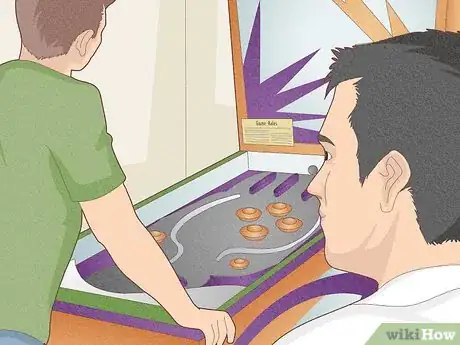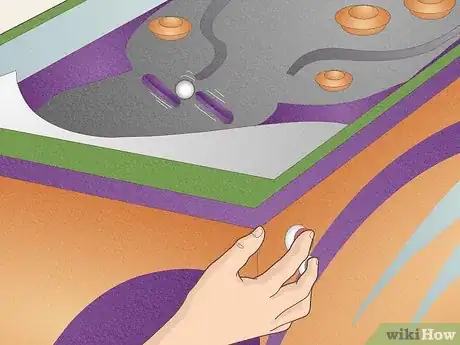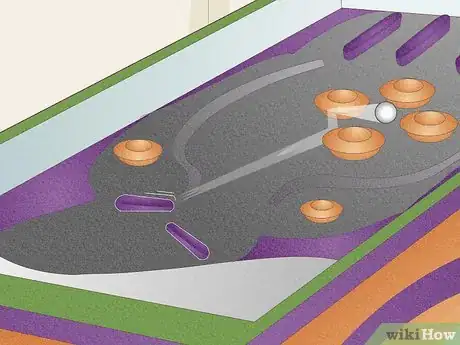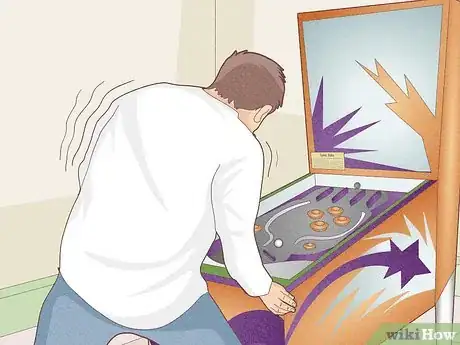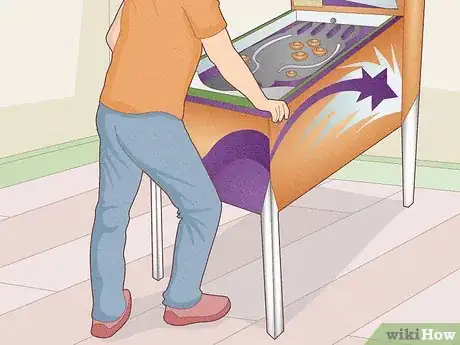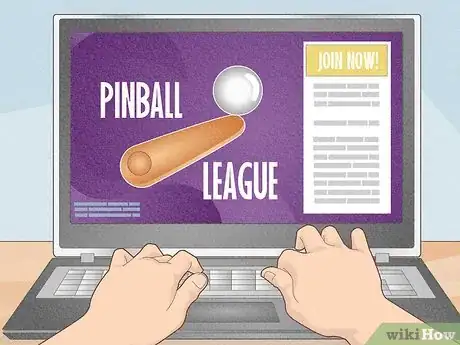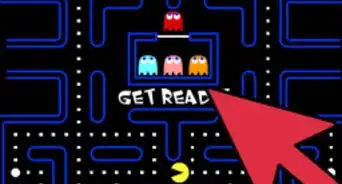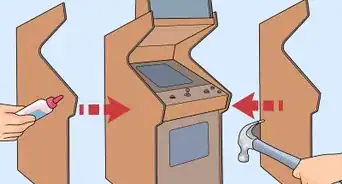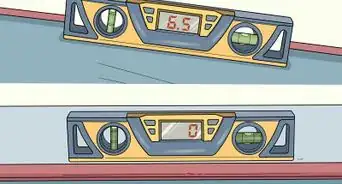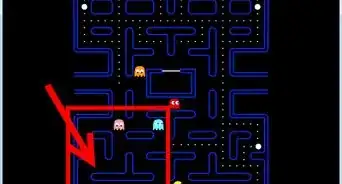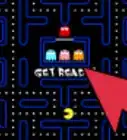X
wikiHow is a “wiki,” similar to Wikipedia, which means that many of our articles are co-written by multiple authors. To create this article, 27 people, some anonymous, worked to edit and improve it over time.
This article has been viewed 167,021 times.
Learn more...
So you see that person putting completely inhuman scores on the local machine and you're wondering how he does it. Fear not! While there is definitely a fair amount of skill required to become a Pinball Wizard, with some basic instruction, you too can be racking up the replays in no time.
Steps
-
1Watch and listen to the game. In order for the profits to trickle back upward, operators need as many players as they can get. This means that the last thing anyone in the industry wants is players walking away from machines confused and frustrated because they couldn't understand what they were doing. To combat this, machines today give the player lots of instruction. But some beginner players don't realize this and this miss easy hints from the game. So while you are playing, look at and listen to the machine.
- "Look at" mostly means watching the display. Most games from roughly 1990 onward will tell the player what they need to do next. Keep an eye also on the play field lights: often if you don't know what you are doing, just hitting a target with a flashing light in front of it will do something.
- "Listen to" means just that. Pinball machines have had speech since the late 70s, and will verbally tell the player about things going on in the game. And even the sound effects are designed the cue the player in certain ways. Start listening to the sounds games make in conjunction with the things they do and you'll start to get the connection. And this isn't trivial: often the sound is meant to tell you something like, "Hey, I'm about to kick the ball at you really hard: be ready!"[1]
-
2Learn the rules. It isn't just ball control, nudging and aim that makes the world's best players. Most modern machines have complicated rule sets, and learning what those rules are is a major part of getting high scores. For instance, many pinball machines from the past decade contain features and other scoring opportunities that can be "stacked" - meaning that two or more features can be activated at once. Rule sheets for most modern titles can be found at the Pinball Archive.[2]Advertisement
-
3Master the basics of flipping. While there will always be an element of chaos in pinball, in truth, very few balls that come down the playing field are completely out of the player's control. This is the key area which determines a player's skill level: bringing the ball under control. There are many advanced tricks, but for now let's address the basics:
- Don't flip both flippers. Flip only the flipper that you need to. Flipping both will actually sometimes cause the player to "drain" (lose the ball) when they didn't need to.
- After you've flipped, drop the flipper back down immediately. Leaving it up leaves a nice big gap for the ball to fall between.
- In general, don't flip any more than you need to. And as you'll discover, that's way less than you might at first think. Once you've got that down, you'll notice that if you hold the flipper up at the right time, you can bring the ball to a dead stop. Great! You've learned how to "catch" the ball. This is a critical element of good play. Catching the ball lets you both stop and think of what shot you want to try to take next and aim carefully for it. There are other things that it also affords the advanced player that we will get into later. And for all players, it lets you stop and take a quick drink, smoke, or answer your cell phone if you're careful.
- Some machines have more than two flippers. Before you start, be sure to look over the entire machine to find all of the flippers, so that you're ready when the ball is near any of them. (For that matter, some machines have more than two buttons. Some have an additional button on one or both sides that have special functions that come into play at various times in the game. Some have buttons on the lock bar, which is the metal bar above the glass that is closest to the player. Some have more than one plunger. Some have a gun or other type of auto-launch mechanism that at times will come into play for reasons other than just getting the ball onto the field. Be sure to note where all of the these things are, and pay attention to when it is time to use them.)
-
4Get good at aiming. You've now gotten to the point where you can bring the ball to a stop consistently and you're learning about what shots you want to try for. Excellent. Now you need to learn how to hit them consistently. The most important rule for aiming is simply that the closer to the tip the ball is, the more to the opposite side it will go. So, for example, let's say you're holding the ball on the left flipper. You drop the flipper and let the ball roll down. If you flip again quickly, you'll send the ball more to the left. If you let the boll roll down a little more towards the tip of the flipper, the more you'll send the ball to the right.
- This is where instruction starts to slowly be taken over by instinct. While the above and other rules are accurate, in truth this is where you will need to start "learning" the machine--what direction and with what force a ball goes in conjunction with when and how you flip all comes down to the individual machine. Even two of the same machine can play very differently dependent upon a wide variety of physical factors: how strong the flippers are and what angles they are at, how clean the machine is, how steep the machine is, etc.
- Aiming is thus a combination of knowing the general physical rules for a pinball machine and knowing the specifics of the machine that is in front of you. If you shoot for a ramp on a machine that is the same as the one that you normally play, but the shot goes early, adjust yourself, and shoot later next time. You're not playing against other players; you're playing against, and with, the machine.
-
5Nudge and tilt. Don't be shy: a certain amount of nudging is considered perfectly fair play, and done right, can often save a ball that might have otherwise been lost.[3]
- Even more than aiming, when and how to nudge is an art form. Even among the experts, no two players approach this with the same philosophy. Some are aggressive, some passive, some judicious, and some wild. What is important is simply to remember that machines do have tilt sensors, and if you tilt, not only does your ball end, but in most games you will lose any end-of-ball bonus points that you might have accumulated; in some cases, this bonus can be enormous.[4]
- Most modern games will also warn you that you are playing too hard. Take the warnings seriously. The way that tilt bobs work, sometimes the moment you get the first warning you are already doomed, since the tilt bob will keep bouncing back and forth and hitting its surrounding ring even if you stopped touching the machine entirely. More often, though, you'll get your warnings, which build up over the course of the ball. Two to three tilt warnings is usually the default.
- Do not hit the front coin door in frustration. Really, don't abuse the machines, period: these are expensive games, most operators don't fix them all that often, and it's just plain anti-social. But added to this is that many 80s and 90s games have "slam tilt" sensors on the front door. If this goes off, your game automatically ends.
-
6Perfect your stance. We've talked about how you play, but how do you stand? What is the best way to position yourself as you flip away? Again, there is no single standard here. Many players simply stand mostly straight, with a slight lean towards the game, no frills. Some hunch down. Some put one leg far ahead of the other. A few cross their legs. And a few even do a Karate Kid and stand mostly on one leg, seriously. Also some players play with gloves to prevent carpal tunnel syndrome. Some play sitting down. Some junior players stand on a milk crate. Some play with and iPod on or with cigarette in their mouth. One player once played routinely with a miner's hat on. Whatever works for you, here is what is important to consider:
- First, whatever stance you choose should be one that you can remain comfortable at for a long time. A good game can last 15-20 minutes. An epic game can last hours. Make sure that whatever you choose it's so comfortable that you don't think about it.
- Second, make sure that your body is physically centered enough that you can nudge the machine forward without losing your equilibrium. A pinball machine weighs about 300 pounds; giving it just the right amount of force takes more physical precision than you would think.
- Finally, don't give a hoot what other people think of your style. Pinball is like bowling or golf in this respect. When the ball is moving you might subconsciously strike all sorts of absurd poses, but as far as the game is concerned, a jackpot is a jackpot. Do what works.
-
7Join a pinball league. "Huh? A pinball league? Those exist?" Why yes, quite a lot of them do. Pinball leagues and tournaments have been around for decades, despite getting scant media coverage. Various web sites listing them come and go. Much of what you'll learn will come from just watching others play and getting ideas. There are also all kinds of online communities; just about every major social networking site (such as MySpace) that includes groups or forums has at least a few pinheads mulling about. However, what is arguably still the best gathering spot is in the ancient land of Usenet, at the newsgroup rec.games.pinball.[5]
-
8Enjoy it. Like any game, the object of pinball is ultimately to have fun. Sometimes, you may need to be reminded of this. Pinball is awfully fun when you're playing well. When you're not, or when the game just isn't being nice to you, it can get highly frustrating. Learn early on when to chalk it up to a spat of bad luck and keep on trucking, and learn when to just walk away and come back for another round another day.
Advertisement
Community Q&A
-
QuestionWhat if a did these steps and I only got 36,000 on a game where the best score is 1,500,000?
 Community AnswerYou should try again. You were probably just unlucky. If you continue to fail, you may need to review the steps and practice.
Community AnswerYou should try again. You were probably just unlucky. If you continue to fail, you may need to review the steps and practice.
Advertisement
Warnings
- Pinball machines are highly complex devices, and are almost never working properly. This fact is no one's fault; it's just the nature of the game. Pin balls are far heavier than they look. The amount of force created by a pinball traveling at the speeds it does (up to 20 mph (32 km/h) in some cases!) link http://www.youtube.com/watch?v=R-thxtiZ-3U is highly substantial, and it's a credit to manufacturers that they stand up as well as they do. Nevertheless, this doesn't mean that you have to keep pumping quarters into games that haven't been maintained in years. Especially the more places to play there are in your area, complain to managers when a machine you are playing isn't working properly. Be specific, and point out to the manager why it's a problem: some assume that as long as the game turns on and takes quarters that that's all it takes to call it a working machine. Don't be rude, but do point out that there are other places you can take your 25-cent pieces. While most honestly don't care, there's no reason to not at least try to use your personal market forces to make the pinball world a better place.⧼thumbs_response⧽
Advertisement
References
About This Article
Advertisement
